
It's been more than 20 years since I interviewed Kathy Stinson for my "Portraits" column in Emergency Librarian [Vol. 14 (5), 52-56] while Kathy was on her first "Book Week" tour with the Canadian Children's Book Centre. Since 2007 marks the twenty-fifth anniversary of the publication of Red Is Best, a picture book that has become a modern Canadian classic, I thought it an appropriate time to revisit Kathy. Just prior to our initial interview session in the 1980s, Kathy's The Bare Naked Book had appeared. Aimed at assisting preschoolers in identifying body parts, this picture book, which is celebrating its twentieth year of being in-print, had a pair of pages, the so-called "penis" and "vagina" pages, which attracted some media attention. Kathy's most recent book, 101 Ways to Dance, a collection of short stories for older teens, may also garner the notice of the media as the volume's 14 stories each deal with some aspect of adolescent sexuality. Though The Bare Naked Book and 101 Ways to Dance are intended for audiences at the opposite ends of the child-adolescent spectrum, they illustrate an important characteristic of Kathy's writing - her unwillingness to compromise in giving her audience the whole "story."
At the time of our initial interview, Kathy had published five books, but now her bibliography boasts some two dozen books as well as a number of short stories in edited collections. Asked if she had ever imagined such an output occurring, Kathy says, "You never know what the next idea is going to be, but I think even then that I knew I was going to be trying lots of different things. When we first talked, I had started writing Fish House Secrets, and the first of my juvenile novels, so already I was writing things that weren't like what I'd started with. I sure never anticipated that For more of the biographical aspects of Kathy's life and a full listing of her books and stories in collections, visit Kathy's website which was constructed by her sister. It can be found at www.kathystinson.com.
This article is based on an interview conducted in Toronto, ON, on September 27, 2006.
Since that time, Kathy informs me that 101 Ways to Dance has been selected as a Top 10 YA Book of the Year by the Ontario Library Association, and the picture book manuscript referred to in this profile has found a publisher.
Kathy Stinson
Profile by Dave Jenkinson.
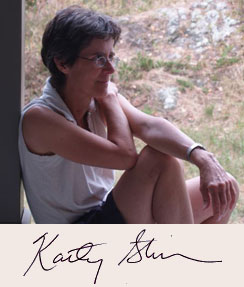 Editor's note:
Editor's note: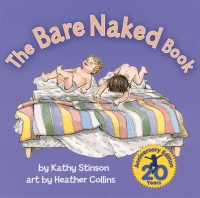
As to the controversy Kathy and I once thought The Bare Naked Book might elicit, Kathy says, "It has and it hasn't. There are schools where they've asked me not to bring that book, but they'll add, ‘Oh, we have it in the school. It's in the staff room.' It's been that sort of thing. One of the more controversial aspects was that some people thought ‘vagina' was the wrong choice of word because it was too ‘sexual,' when ‘the book was really about peeing.' Also, because the vagina isn't visible. I think strong feminists thought that ‘vagina' was more about the male interest in female genitalia. The publisher and I debated words that might have been better a better choice at one point, but when the book got reprinted, we didn't re-discuss it. The book was just redesigned and redone. I guess reaction to The Bare Naked Book was prep work, in a way, for some of the controversy that would be generated by stuff I'd write later."
When questioned about how she believes she has changed over the years as a writer, Kathy replies, "I spend more time at it now than I did then. And I know how much I don't know. I know now that every book is a new beginning. Sure, I've learned things about the craft that help with revisions and sometimes even with planning, but every story has its own learning curve. There are some things you just have to learn in the writing of each story. I might know more now -- in theory -- about characters having to have motivations for the things they do and say that are plausible and convincing, and that having two characters who are dissimilar increases chances of conflict, but, until I get into a story, I won't know how all that's going to play out or what's going to be most significant -- what event or snippet of dialogue. I might have a character and a situation when I start out, and even think I know where the story is going to end up, but it can always still go in a different direction. And probably will."
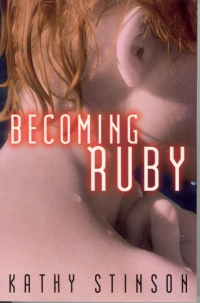
"As an example, let's look at the novel Becoming Ruby. It started out as a very long short story about a girl getting ready to leave home from the time she's four-years-old until she's nineteen. It was going to be told through a series of vignettes, all pointing and building to that moment when it was time for her to go, but that's not what it became, because after I decided to turn it into a novel, I thought, ‘Let's just focus on that year or so when she's 15-years-old, and slice away a bunch of years before and after that.' Some of the earlier stuff ended up coming into the novel as backstory, but until I got deeper into the 15-year-old material, I couldn't really tell what was important in that background stuff."
While Kathy's first books were picture books, she has since branched out into other genres, with each bringing its own challenges. "With novels, it's the stamina. It's a huge commitment not only of time but also of emotional energy. You're just so ‘in' it for so long. But I love doing that. It's like getting to read a book, only you get to be in it for a long, long time. I think picture books are the hardest for me, and a lot of people think I've left them because I haven't published one since the early 90s, but I haven't left them. I'm just not writing the kind of picture books it seems people want to publish these days. A long time ago I figure out that a picture book almost always comes ‘right' really soon, or else it just isn't going to. That seems to be the pattern for me anyway. With a novel, I can set it aside and come back to it a year later and see it with fresh eyes and then do some things that will turn it into something quite readable, even compelling. I can't seem to do that with a picture book."
Whereas in the 1980's Kathy said that writing for older readers was a challenge because "it's sort of like starting all over again," the 2000 Kathy, a grandmother, is getting another chance to start over in writing for the very young. "Having grandchildren has definitely had an impact on the books I've worked on. I've recently written what I think is the best picture book I've written in years, in part because of having grandchildren who live only an hour away, in Toronto. Three of our grandkids are in Halifax, so the contact isn't regular enough to have made a real impact, but having my granddaughter walking around in my house and doing stuff like putting things into things and taking things out of things definitely helped steer an idea I had in a certain direction. That manuscript has actually come close to being picked up but not quite, and, if I ever finish the thing I'm working on now and the novel that's waiting for me to finish the thing I'm working on now, maybe I'll get back to that picture book and do with it what it needs."
"The novel is finished, in a way, but it needs another rewrite before I can submit it. I did submit it a while ago to somebody who said they wanted to see my next YA novel, and I pressed to get it finished, but then they decided they didn't want it after all. Before submitting it to another publisher who hasn't specifically asked to see it, I want to take it further. I've figured out some things I'd like to do with that story that probably should have been done before I submitted it the first time. Having someone say, ‘We want to see your next thing,' made me think, ‘Isn't it wonderful to be writing something that somebody actually wants? I'm going to make myself this deadline, and I'm going to get that into them, and it's going to be great.' But I've found out through that project and the one I'm working on now (a biography I'm under contract for that has a deadline), that there's a lot to be said for just writing quietly by yourself on spec in the hopes that maybe some day somebody will be interested. Ironically, when that has been my situation, I haven't liked it. I always thought, ‘Oh, I wish I had a contract and knew that somebody was going to want this.' But I've discovered I don't really like the pressure of it."
"Having a contract, or even a publisher who wants to see something, probably rushes the creative process a bit. For instance, with that novel I submitted, it had lots going for it, but there was a whole thread of it that really had not even been allowed to percolate. Had the publisher said, ‘Great. We've got your next book slotted into the schedule. Here are your editorial comments. Go, go, go,' the result might have been a ‘good enough' book, but it's nice to have the time to make it better than ‘good enough'."
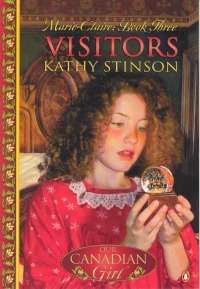
"Having just said that I don't like the pressure of external deadlines, I was working to deadline with Dark Spring, the first Marie-Claire book in the ‘Our Canadian Girl' series, and that experience was great. I don't really know what the difference was there. I had some pretty scary moments because, of course, to write historical fiction you're researching, researching and researching, and I was getting very close to the time when they'd want to see the manuscript and I hadn't even started. I'd sit down thinking, ‘I'm ready to start,' but right there on page one I'd realize, ‘I've done all this research, but I still don't know what Marie-Claire's going to have for breakfast.' It turned out, in the end, that writing was happening in my head, in a way, while I was doing all the research, so when I finally sat down to write, I had a first draft a week later. Of course, it was only an 8,000 word novel and that makes a difference."
"I originally thought I was going to be writing a trilogy about Marie-Claire, but Penguin decided they wanted each girl to have four books. I hope it doesn't show, but Books Three and Four were originally Book Three. The change meant starting Book Three at an earlier point than I thought it would start, and it had a different main thread than I originally thought it was going to. Book Four is essentially the originally intended Book Three (but starting a little later), because I knew where I wanted the series of books to end up. I selected that historical period because a couple of years before the Penguin opportunity came up I had read Michael Bliss's book Plague, which is about the smallpox epidemic in Montreal, and had thought maybe some day I'd write a book set at that time and in that place. I'd thought my central character would likely be a teenager because that's where my head was then -- in adolescence. But when Penguin said they wanted to do a series about girls who were 10, I thought, ‘I haven't done anything with the idea; there's no reason my character couldn't be 10.'"
Queried about what she would like to write and have published that she hasn't, Kathy says, "I've written poetry that hasn't been published. And I've written an adult novel that I still intend going to back to. It's funny how things happen. I was working on that adult novel when Penguin said they wanted my next YA novel, and I thought, ‘I wonder if this could be YA.' I started twisting it around and changing it and thinking maybe it could be, but it really wasn't YA and deep down I knew it wasn't. I also knew it had too much going on in it, so what I ended up doing was I pulled out one of the threads that really intrigued me, and used it to start another novel -- the YA novel I'm now revising."
"I have a number of projects that I'd like to get back to. The adult novel that I got the idea for when I was hiking the Bruce Trail in Ontario some 10-15 years ago. A picture book manuscript that I kept trying for years and nobody wanted it -- I finally figured out how it's going to work as a juvenile novel and have actually started writing it, but it hasn't pulled me as strongly as some of the other things I've been working on. You know, I never thought I would write horror fiction, but then Red Deer said they wanted to do an anthology. I got their letter saying essentially, ‘You write short stories. Do you want to write one for us?' and I thought, ‘No, I don't write horror.' Well, two stories later, I guess I now write horror fiction too."
Kathy also recognizes that her work habits have changed. "I start earlier in the morning, and I guess that's partly because I don't have kids at home any more. It used to be that, if I got started at 8:30, that was an early start. Now I like to get out of bed, ideally at 6, and just go to my desk. Sometimes, it's not until 7; it depends how pressed I'm feeling." At the same time, Kathy observes, "I don't know where the time goes. I don't have kids at home any more, so where's the time going? It used to be that I'd meet people for lunch and go for a walk in the afternoon. I often built more of that kind of downtime into my days than I do now. It could be that I'm more satisfied now to spend time just with myself and my garden and my books. I may also be more conscious of the fact that I don't have forever to finish things and I want them finished. I look at other writers who are so prolific and think, ‘Why do I take so long to get things out.' But then I've only had one year since I started writing when I didn't have something published. So I guess I don't do badly, but I still often think that if I could just spend more hours at my desk, I could be more prolific."
Because asking authors which of their books are their favourites is like asking a parent which child is her/his favourite, I asked Kathy which books have made her happy and which books had she hoped would do better. Says Kathy, "The Marie-Claire books made me happy just because I really had fun writing them even though I cried while I was writing them. Not until she wouldn't eat the apple did I know that Marie-Claire's sister was going to die. Then I thought, ‘Oh, no, I've already killed off two of her brothers. Now her sister's going to die too?'"
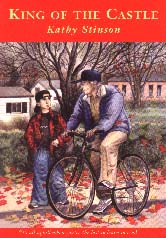
"Another book that makes me very happy is my chapter book King of the Castle, about a school caretaker who can't read. I've had the chance to meet with adult learners who love the book, and knowing that they do really pleases me. Also, I read the book to my grandson this summer. He's just turned seven, and he's in French immersion and doesn't read yet. When we were finished it, he said, ‘I want to learn to read now so I can read that book all by myself.' I thought, ‘Wow. What more could any writer want?'"
"I love Becoming Ruby, but I'm disappointed in how it's done. I guess I had this notion that once you're published with Penguin Canada, your books will be out there with Penguin UK and Penguin US, too, but that isn't automatic, and in the end, it's just another book. It seems it doesn't matter what I write, it's going to be just another book. But I've done one that's a biggy, Red Is Best and even though I'll never do another Red Is Best, I know I'm lucky because lots of writers don't have that."
"I admit that I always have fantasies about what a book's going to be and the impact it's going to have and the attention it's going to get and the awards it's going to attract and all that kind of stuff, but I say to myself, ‘Don't waste a lot of time thinking about this because it ain't gonna happen.' And it doesn't need to happen. The best part of this business is the writing and sure, reader response makes me happy, and obviously I'm pleased that Red Is Best has sold as well as it has, too, because it's enabled me to make my living doing this."
"In the early 90s, I had a great time writing The Fabulous Ball Book, a nonfiction book, but commercially it was the biggest flop going. I still remember the feeling of beetling along the boardwalk to the Beaches' library to do some more research and just how exhilarating that was. It was fun to do, but as a book, nothing."
More than two decades ago, Kathy wrote Mom and Dad Don't Live Together Any More," a picture book that had its roots within her own personal life. In the 1990's, she wrote about another event that some families experience - adoption - in Steven's Baseball Mitt. Tackling this subject arose because of Kathy's connection with Heather Collins who had illustrated Kathy's texts for The Bare Naked Book and The Dressed Up Book. "I'd become friends with Heather while we were doing those two books, and a friend of hers whose son was adopted said to her, ‘Do you think Kathy would ever write a book about being adopted because none of the books out there seem to be what I want my son to have?' And I responded, ‘No, I would never think about doing that. I'm not adopted. My kids aren't adopted. I have no way into that story at a really personal level.' Nonetheless, her question planted the idea. I did some reading and thought, ‘Hmmm, maybe I could.' I met with Heather's friend to see what it was that she thought was lacking, and I ended up writing the book."
"The final product was hugely disappointing because the publisher saddled it with a title that was so inappropriate. It was horrible to go into schools with my books available for purchase after the reading because, if a kid wanted to buy that book, I felt I had to say, ‘You do know this book isn't about baseball. It's about being adopted.' If they wanted a book about baseball, they were disappointed, and if they already knew it was about being adopted, I'd made them feel like there was something wrong about wanting a book about being adopted. Often students would ask, ‘Why is this book called Steven's Baseball Mitt when that's not what it's about?' After some words were exchanged with the publisher, they pulled it from their catalog, and I was glad; I didn't care that it hadn't sold out its print run. Later, someone in the States approached me, disappointed that they couldn't get the book anymore, and said they would help me find another publisher for it. The book eventually was eventually republished in the US with another title, I Feel Different. In spite of not having had a personal experience with adoption, I think I did a good job with the subject because some people, having read the book, assumed I was adopted. That made me feel pretty good."
Kathy's life partner is Peter Carver, an editor for Red Deer Press. Asked if having a truly in-house editor is an advantage, Kathy responds, "I eventually reach a point where I would like Peter to look at my stuff, and his feedback can be helpful. It's funny though how often it happens that he can say something to me, and it's not until somebody else says the same thing that I ‘get' it. It's crazy because there are writers all over the country who want Peter for their editor, and here he is, right there in his office next to mine. I think I've gotten better at hearing what it is that he wants to say to me, but maybe he has also just gotten better at saying only the really important things."
In beginning to talk about the origins of 101 Ways to Dance, Kathy says, "I've just realized there's somebody who's not in the acknowledgments who should be, and that's Budge Wilson. I would never have undertaken writing short stories if I hadn't read her collection, The Leaving. Budge's were the first short stories I read that finally made me ‘get' the genre. So often before, I'd read short stories, they'd end, and I'd think, ‘Well, yah, so? Why did we end here? Why did we start there? Why am I supposed to care about these characters anyway?' I hadn't felt that way about all short stories, but that was my general sense of the genre, and I was certainly far more interested in novels. So, in a way, the beginning of 101 Ways to Dance was Budge's stories planting the idea that short stories can be interesting and maybe I should try writing one some day."
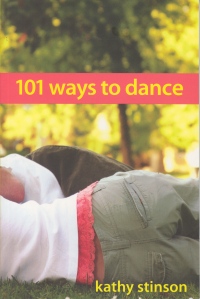
"Some of the stories in 101 Ways to Dance have been around for a while, because short stories were something I went to between other projects or when I was just fed up with whatever longer project I was working on. Short stories were something I ‘played with'. (All writing should feel like play, I think, but sometimes you get to a stage with a project where it just isn't fun.) So, I was playing around with stories and telling people in my writing classes to ‘mine your own experience for story ideas', and I realized I wasn't doing that myself. I had done it for books like Red Is Best and Big Or Little?, but hadn't been doing it more recently."
"Consequently, I just started playing around with some stuff that I remembered experiencing as some point in my life. And whenever I wrote about being a teenager, I often ended up writing something about being horny. When I eventually started recognizing this common thread, I thought I should try putting together a collection. At one point, I thought the long short story that eventually became Becoming Ruby was going to make up half of the collection. Sarah Ellis was writer-in-residence at the University of Toronto then, and she read what I had written. About the ‘Ruby' material, she said, ‘This is not a short story. These are notes for a novel.' So out it came, and that left a pretty big gap which meant I needed to write some more stories."
"In retrospect, I've realized that there's one of the ways to dance that's missing. There's nobody by themselves in the stories, and that's a pretty important one. If I could go back and do the book over again, that's what I would change. It's funny that I missed masturbation because it's come into other stories of mine. It's there in a very understated way in Becoming Ruby, and it was there in a draft of Fish House Secrets. I took it out before the book was finished though, because it had become a bigger scene than it should have been for the story."
"The only story in 101 Ways to Dance that isn't explicitly sexual is ‘Itchy,' but, between the lines, there might actually be more sex in that one than in any of the others. It's sort of fudged so that readers get what they're ready to get from it. I think that's important, and I don't do it as well as say a writer like Brian Doyle. I thought his Boy O'Boy was just so brilliant in his whole treatment of sexual exploitation. A kid who isn't ready to know exactly what that meant isn't hit over the head with it, and I think that's a really great thing for a writer to be able to do, to have some situations that readers see one way if that's where they're ready to go, but if you're not ready, then you see it another way."
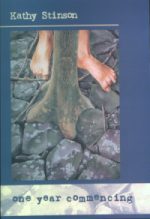
"After a group of kids had read my novel One Year Commencing, I was approached by one of them who wanted to know if Kim's mother was or was not gay. When I asked, ‘What do you think?" she replied, ‘Well, I think she is, but my friend thinks she's not.' I said, ‘In my mind as I was getting to know these characters, that's what I thought was the case, but I purposely wrote it the way I did because the mother's sexuality wasn't at all important to this story. So, if not all readers wanted to think Kim's mom was gay, it didn't really matter."
Two decades ago, Kathy said, "Titles are the hardest thing for me. It's almost always the last thing to be decided." While she acknowledges that she still sometimes has difficulties in creating a book's title, such was not the case with 101 Ways to Dance. "I knew this was the right title. But when Second Story Press said they wanted to publish the collection, they said, ‘We'll have try to think of another title,' and even changed the title in the contract. Over the next year or so, I talked to a lot of teenagers I had contact with, including the teen advisory groups at the Vaughan libraries where I was writer-in-residence, all in hopes of building the case for my title. When it finally came to the editing of the manuscript, Second Story said, ‘Oh, by the way. Your title is a great title,' so I didn't have to make my case after all. I did go along with another change they requested though. Some of the stories were originally written as poetry, but Margie Wolfe at Second Story said, ‘We're going to have a hard enough time selling short stories without you throwing poetry in as well. Please don't insist on the poetry.' I rewrote those pieces in prose."
The "under contract" nonfiction book to which Kathy referred earlier is one she is writing for Tundra. Its subject is Cornelia Oberlander, one of Canada's premier landscape architects and a recipient of the Order of Canada. Says Kathy, "She's 85-years-old and still practicing. She was born in Germany, left during the Holocaust, and was one of the first women to attend the Harvard School of Design after the doors were opened to women. She's so passionate about her work that, when I met her, it was incredibly infectious. I met her through Peter. His father, Humphrey Carver, and Cornelia's husband, Peter Oberlander, used to work together, in Ottawa, before Peter moved to Vancouver, and they had the same birthday. Humphrey used to call Peter O on their joint birthday."
"After Humphrey died, Peter picked up the tradition of calling Peter O on his birthday, and, when Peter O. heard that we were going to be in Vancouver, he said, ‘Well, let's have lunch, and why don't you bring Kathy along and I'll bring Cornelia. I'd only read about two lines about Cornelia in a gardening magazine when I met her, but while we were having lunch, I thought, ‘What an amazing woman. I'd love to know more about her.' I said, ‘Cornelia, has anybody ever written a biography about you?' thinking I'd like to read it. She said, ‘No, and no one who has ever written about me has quite got me.' She turned to me then and said, ‘Maybe you'll be the one.' I thought this quite remarkable because I don't think she knew anything about me except Red Is Best which she had given to numerous children over the years, and you don't really make the leap from ‘You wrote Red Is Best' to ‘You could write my biography.' I didn't know whether she was serious or not, and I certainly wasn't going to pick it up because, ‘Biography. Well, I don't write biography. ' (Just like I didn't write horror fiction, I guess.)"
"Cornelia had to go off for something after lunch -- busy, busy, busy -- and her husband took us on a tour of some the landscaping she'd done around the University of British Columbia, and it was just all so interesting. Before leaving us, Cornelia said, ‘Before you go back to your friends' place, come by the house, and I'll have something to give you.' We did, and she gave me an envelope with some photocopies of articles that had been written about her and her work. Once I'd read them, I was hooked. The book is to be 80 pages long, but I wish it could be a bit longer because there's just so much material. I don't doubt that the book will benefit from the length constraint put upon it though, because I'll have to get right to the point and cut out some of the stuff that I think's really neat but maybe isn't all that neat for my particular audience. The biography is pretty all-consuming right now even though it's not coming out until 2008. There's a lot of stuff that they want ahead of time, partly because the book will have heavy design demands too with all the various visuals and so on."
"I'm writing it partly because Cornelia herself is such a fascinating subject, but so also is her profession. I don't think many people know much about landscape architecture. The book will be for kids old enough to be thinking, ‘I wonder what I'm going to do with myself when I grow up?' I did think about whether it should be a book for adults, but decided that a book for adults would require more technical stuff about the profession than I was interested in going into or would be qualified to go into."
One aspect of writing that has not changed over Kathy's career as a writer is the economics of the profession. "I still go out and do school visits, I still speak at conferences, I still do some teaching, and I still do some editing. All of that's the same." Though Kathy says she doesn't do so much teaching now, "I did a writer-in-residence in Kitchener several years ago now, and some of the people I worked with there have wanted to continue working with me, and I have done that on a fairly sporadic basis. Also, Peter and I ran a writing workshop down in Nova Scotia in September which was fabulous. We had six writers living in with us for the week. There was time built in for writing and some for workshops. There was free time too, so people could walk the beach or socialize. Everybody there was working on a novel for children or adolescents."
"I wouldn't mind doing more freelance editing. But truthfully, I would love it if my writing alone could support me. I used to think that it would some day -- once I had enough books published. But x number of books later, guess what, it ain't gonna happen. I like doing the school stuff when I'm actually in the schools and with the kids, but if I'm looking at my weekly calendar and see there's a day where I'm going into a school, I don't say, ‘Oh goody.' It's more like, ‘Oh, damn! Another day away from my desk.' I love the writing, and that's what I most want to be doing. So it's good that I like being in the schools once I get out there. I'm also a homebody, and so in that way the editing work suits me, even though the pay is pretty crappy compared to the school visit stuff. I can do the editing at home and can fit it in. I also really enjoy editing, and it's less exhausting than the school visits."
Reflecting on her years as a writer, Kathy comments on how she has gained in other areas of her life, especially in terms of encountering Canada. "I grew up in Ontario and once in high school I went to Quebec as part of a short French exchange program. Because of my writing, I've now been in all the provinces and territories except the Yukon and I'm going there next week. How many Canadians get to see so much of the country? I'm pretty lucky. My sense of Canada is one of wonder, ‘Wow, this is my country too.' But I've also thought, ‘Wouldn't it be neat if I could afford to just say, ‘That's all folks. I've done it all, and I don't do that anymore.' But I do need to earn a living, and I do like doing the travelling, but, as I said before, I think I'm getting to be a homebody more and more as time goes on. I'd much rather speak to a room full of adults than a roomful of kids. It's not because I don't like kids, and it's wonderful to have their response. But, in terms of impact for the time I'm spending, I feel that if I talk to a bunch of adults -- teachers, parents, librarians, booksellers or whoever -- they're going to go out and reach that many more kids than I will. But then, I get all these nice heartwarming stories about the impact I've on ‘that kid', the one over there who never wrote anything down before you came to the school, and that sort of thing. And really, what more impact could you want than that?"
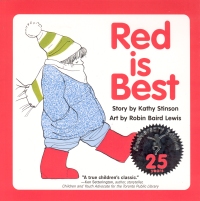
Returning to the idea of books with which she has been pleased, Kathy says, "About Red Is Best, people will start telling a story about a kid who learned to read on the book and say, ‘Oh, you've probably heard this before,' and I'll reply, ‘Yes, I have, but please tell me again.' When I was touring in Alberta, I had some down time before going to a radio station for an interview, and I ended up sitting in the classroom of a teacher-friend until it was time to go to the studio. She had her grade ones reading in partners, and one boy's partner got called out of the room. I went over to see if he wanted me to fill in for his reading partner, and it turned out he was reading Red Is Best. To sit there with a kid in grade one who's going ‘I......like.....', to have the experience of seeing how much effort goes into reading those first books and how much that boy wanted to make that effort -- it was very moving. I guess in terms of making a difference in the world, this is where I've done it. I guess I'll always BE Red Is Best. I used to fight that and say, ‘You know what? I wrote something else!' I don't feel the need to do that any more."
